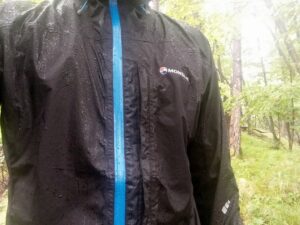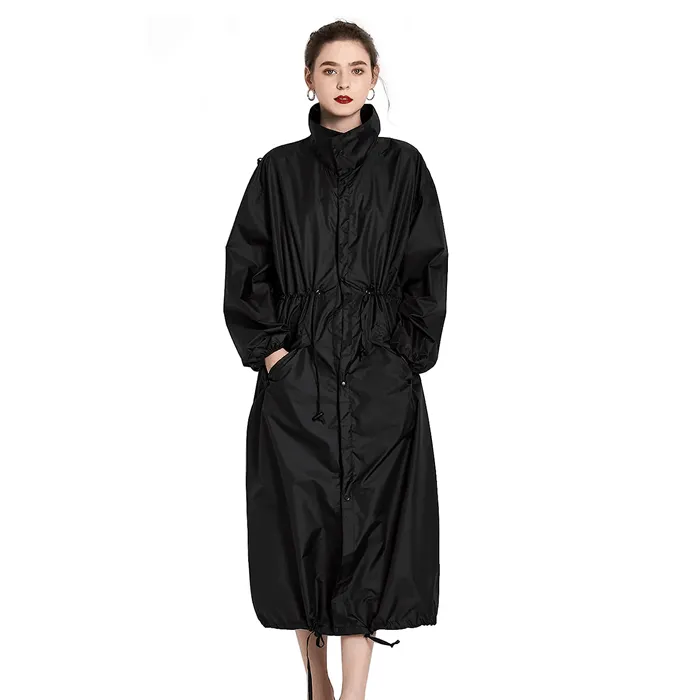
Windbreakers have become increasingly popular in the last years and many hikers have switched from rain jackets to these minimalistic shell layers. Windbreakers are lighter and pack smaller than rain jackets and are thus perfect for lightweight hiking. Nevertheless, it’s important to know that a windbreaker performs quite differently than a rain jacket. A rain jacket is, as the name suggests, primarily intended for protection against the rain, but it also provides good protection against the wind. Windbreakers, on the other hand, provide very little protection against the rain, but efficiently block the wind. I have a windbreaker as well as two rain jackets, and I always decide what to wear/carry in my backpack after checking the weather forecast and conditions on the trail in question. In the following I will explain the differences between windbreaker jackets and rain jackets to help you choose the right garment for your needs.
Air permeability

Windbreaker VS Rain Jacket – Rain jackets are made of multiple layers and have a membrane/coating which significantly reduces the air permeability
Air permeability (better known as breathability) is important when it comes to hiking, backpacking and sports apparel in general because you will sweat extensively throughout the activity if your clothes are not air permeable. Rain jackets are typically made of multiple thin material layers and have a membrane or a coating to prevent rain drops from penetrating the garment. This material structure significantly reduces the air permeability and therefore rain jackets are known to be the least breathable activewear, although breathability can vary hugely between high-quality rain jackets and cheap ones. You can read more about this in our article Rainwear: Hydrostatic Head and Breathability. Windbreakers typically provide better air permeability because they are made of a single layer of tightly woven synthetic fabric which blocks the wind – but not the rain (at least not for long). As such, windbreakers are perfect for highly aerobic activities like running, fast alpine ascents etc. Air permeability can also vary hugely between high- and low-quality windbreakers.
Weight and packability

Windbreakers almost always pack smaller and weigh less then rain jackets. Therefore, they are very popular among lightweight hikers. Everybody should indeed use lightweight gear for hiking because lightweight gear reduces discomfort and strain on the body. You can read more about this in my article Why hike lightweight. So, how big is the difference in weight? A windbreaker for men can weigh as little as 80 grams (3 oz.) while it’s hard to find a rain jacket that weighs less than 200 grams (7 oz.). As for the packability, windbreakers obviously pack smaller than rain jackets. My jacket for example packs so small that I avoid putting it in the main compartment of my backpack because I have trouble finding it if I need it later. In terms of packed size, a high-quality rain jacket typically has the size of a big apple while a top-tier windbreaker has the size of a small mandarin. The difference is not that big, but if you are, for example, going climbing and you want your shell layer attached to the climbing harness, a windbreaker will be less bulky.
Comfort

Windbreaker VS Rain Jacket – Windbreakers are more comfortable to wear because they provide better stretch and freedom of movement
Rain jackets belong in the category of hardshells, which – as the name suggests – are somewhat stiff garments. Therefore, they are not the most comfortable apparel to wear. Nevertheless, there are exceptions such as rain jackets made of Polartec NeoShell fabric which are known to be very stretchy. However, these jackets are also very expensive. Windbreaker jackets on the other hand provide much better stretch than most rain jackets and thus greater freedom of movement. They are also less bulky and less noisy (stiff waterproof fabrics tend to rustle when you move). All in all, windbreakers are a better choice in terms of comfort. However, they provide nowhere near as good protection against precipitation as rain jackets.
Protection against the precipitation

Windbreaker VS Rain Jacket – Without a doubt rain jackets provide better protection against the rain
The primary function of any rain jacket is to keep you dry in (heavy) rain. Nevertheless, as rain jackets are made of relatively impermeable materials, they also block wind quite efficiently. Therefore, a rain jacket is a great option when you can’t rely on weather forecast (for example for long backpacking trips) and you need a versatile protection against all the elements. Windbreakers do provide some protection against the rain, but they will for sure not keep you dry for long. Unlike rain jackets, they don’t utilize membranes/coatings for weather protection, but merely a tightly woven fabric treated with DWR. However, windbreakers provide excellent protection against the wind. As such, they are perfect for short adventures (day hikes, trail running etc.) in dry but windy weather.
Durability and price

Windbreaker VS Rain Jacket – Windbreakers are made of thinner materials than rain jackets and thus tear faster
Windbreakers are more delicate than rain jackets because they are typically made of thinner fabrics. Nevertheless, many top-tier rain jackets are also quite fragile; the material simply can’t be robust and lightweight at the same time, and thus more or less all high-quality rain jackets are lightweight rather than heavy and robust. Therefore you should be careful not to get whichever garment you choose to wear caught on rocks, thorns, branches etc. because it will tear. Windbreakers are, however, easier to repair because the fabric can be sewn by hand or machine without affecting performance. Mended tears might block wind less efficiently, but the garment should still preserve its functionality. It’s harder to sew a rain jacket and preserve its performance because you will obviously make holes into the membrane or coating, through which precipitation can enter and spread.
When it comes to price, rain jackets are in general more expensive – at least if we are comparing products of the same quality. Nevertheless, high-quality and super lightweight windbreakers can also be very expensive.
Conclusion
So, should you buy a windbreaker or a rain jacket? If you mostly hike in dry weather, a windbreaker is the obvious choice because it provides good breathability and is lighter and more packable than a rain jacket. You can also use it for running and other highly aerobic activities which is indeed a benefit. Now, if you often hike in rainy weather, in areas with unstable weather (for example at high altitudes) or do long backpacking trips where you can’t rely on the weather forecast, a rain jacket is a better option. For such conditions a windbreaker doesn’t provide appropriate protection against the elements.
I typically use my windbreaker jacket for day hikes and fast alpine ascents in the Alps in dry weather. For all other trips I use my rain jacket because it’s more versatile – it provides protection against the wind as well as protection against the rain.
I’d love to hear about your thoughts on windbreakers and rain jackets. Write them in the comments section below.
































